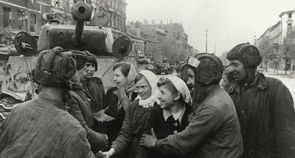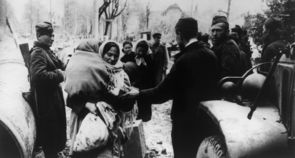Wednesday, 2 Mai 1945
While the fighting in Berlin continues, the German General Helmuth Weidling begins in the early hours of the morning to draft the surrender order. From noon on May 2, loudspeaker vans each with one Soviet officer and one German military man will drive through the city to announce the surrender order. In the cellars of the Reichstag, fighting continues until 1 pm. From about 5 p.m. on, all fighting in the city ceases.
The exploitation by the National Socialist regime ends for about 370,000 forced labourers in the entire Berlin area - civilian deportees, prisoners of war and concentration camp inmates. Quite a few of them are still at their workplaces at this moment. Some had already fled the camps in the days before or were hiding in the city. Others waited in the camps, their workplaces had not been accessible for days.
The condition in which the Soviet units find the forced labourers varies considerably. Those who were used in agriculture or in the service sector are usually a little better off than their comrades in arms industry. The liberated concentration camp prisoners are in a particularly bad shape.
The enormous number of liberated forced labourers confronts the Allies with enormous challenges. In the next days and weeks, many of them set off for home on foot or with the help of various carts. Others make their way to the Displaced Persons Camps, which the Allied military administrations are setting up throughout the city. Return transports are organised from here. Yet others stay in the city, not knowing where to go.
For while some people experience this day as liberation, others shy away from returning home. They fear to be branded as traitors or suspected of collaboration because they have worked for "the enemy". Once back home, most former forced laborers will not talk about their fate for decades.

